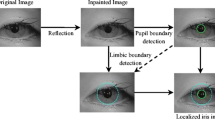Abstract
Person identification by the iris is one of the leading technologies in biometric identification. The visible region of the iris has the form of a ring enclosed between the pupil and the sclera partially occluded by eyelids, eyelashes, and flashes. An important problem is to find the non-occluded part, i.e., divide the pixels of the image into two classes: “iris” and “occlusions.” We propose an approach to solving this problem based on distinguishing a support set, i.e., a part of the ring which is free from occlusions with high probability, and subsequently finding all elements that have similar texture features. As the support set, based on experiments we have chosen a sector of the ring with minimal brightness excess. We divide the pixels with a classifier based on a multidimensional Gaussian trained on the support set. Local classification noises are partially removed by morphological postprocessing. Applying this algorithm to construct biometric templates improves recognition.
Similar content being viewed by others
References
Davies, E., Machine Vision. Signal Processing and Its Applications, Burlington: Morgan Kaufmann, 2005, 3rd ed.
Matveev, I.A., Algorithm for Iris Localization by Interrelated Maxima of Brightness Gradient Projections, Mekhatronika, Avtomatiz., Upravlen., 2009, no. 5, pp. 62–68.
He, Z., Tan, T., Sun, Z., et al., Robust Eyelid, Eyelash and Shadow Localization for Iris Recognition, in 15th IEEE Int. Conf. on Image Processing, 2008, pp. 265–268.
Wildes, R.P., Iris Recognition: An Emerging Biometric Technology, Proc. IEEE, 1997, vol. 85, no. 9, pp. 1348–1363.
Daugman, J., How Iris Recognition Works, in Proc. Int. Conf. on Image Processing, 2002, vol. 1, pp. 33–36.
Daugman, J.G., High Confidence Visual Recognition of Persons by a Test of Statistical Independence, IEEE Trans. Pattern Anal. Machine Intelligence, 1993, vol. 15, no. 11, pp. 1148–1161.
Bowyer, K., Hollingsworth, K., and Flynn, P., A Survey of Iris Biometrics Research: 2008–2010, in Handbook of Iris Recognition, Burge, M.J. and Bowyer, K.W., Eds., London: Springer, 2013, pp. 15–54.
Joshi, N.P., Shah, C.P., and Kaul, K., A Novel Approach Implementation of Eyelid Detection in Biometric Applications, Nirma Univ. Int. Conf. on Engineering (NUiCONE), 2012, pp. 1–6.
Sankowski, W., Grabowski, K., Napieralska, M., et al., Eyelids Localization Method Designed for Iris Recognition System, 14th Int. Conf. on Mixed Design of Integrated Circuits and Systems, 2007, pp. 622–627.
He, Z., Tan, T., Sun, Z., et al., Toward Accurate and Fast Iris Segmentation for Iris Biometrics, IEEE Trans. Pattern Anal. Machine Intelligence, 2009, vol. 31, no. 9, pp. 1670–1684.
Krichen, E., Garcia-Salicetti, S., and Dorizzi, B., A New Probabilistic Iris Quality Measure for Comprehensive Noise Detection, First IEEE Int. Conf. on Biometrics: Theory, Applications, and Systems, 2007, pp. 1–6.
Daugman, J., New Methods in Iris Recognition, IEEE Trans. Syst. Man Cybernetics, 2007, vol. 37, no. 5, pp. 1167–1175.
Zhang, D., Monro, D.M., and Rakshit, S., Eyelash Removal Method for Human Iris Recognition, ICIP, 2006, pp. 285–288.
Min, T.-H. and Park, R.H., Comparison of Eyelid and Eyelash Detection Algorithms for Performance Improvement of Iris Recognition, 15th IEEE Int. Conf. Image Processing, 2008, pp. 257–260.
Li, Y. and Savvides, M., A Pixel-Wise, Learning-Based Approach for Occlusion Estimation of Iris Images in Polar Domain, in Proc. IEEE Int. Conf. on Acoustics, Speech, and Signal Processing (ICASSP’09), 2009, pp. 1357–1360.
Gan’kin, K.A., Gneushev, A.N., and Matveev, I.A., Iris Segmentation Based on Approximate Methods with Subsequent Refinements, J. Comput. Syst. Sci. Int., 2014, vol. 53, no. 2, pp. 224–238.
CASIA-IrisV3: CASIA-Iris-Lamp image database, Chinese Academy of Sciences, Institute of Automation. http://www.cbsr.ia.ac.cn/IrisDatabase.htm
ICE database. http://www.nist.gov/itl/iad/ig/ice.cfm
Solomatin, I.A. and Matveev, I.A., Localizing the Visible Part of an Iris by a Local Texture Features Classifier, Mashinnoe Obuchen. Analiz Dannykh, 2015, vol. 1, no. 14, pp. 1919–1929.
Ahmed, N., Natarajan, T., and Rio, K., Discrete Cosine Transform, IEEE Trans. Comput., 1974, vol. C-23, pp. 90–93.
Loeffler, C., Ligtenberg, A., and Moschytz, G.S., Practical Fast 1-d DCT Algorithms with 11 Multiplications, Int. Conf. on Acoustics, Speech, and Signal Processing (ICASSP’ 89), 1989, pp. 988–991.
Otsu, N., A Threshold Selection Method from Gray Level Histograms, IEEE Trans. Syst. Man Cybernetics, 1979, vol. 9, pp. 62–66.
Mahalanobis, P.C., On the Generalised Distance in Statistics, Proc. National Inst. Sci. India, 1936, vol. 2, pp. 49–55.
OpenCV v.2.4.10. http://opencv.org
Masek, L. and Kovesi, P., Matlab Source Code for a Biometric Identification System Based on Iris Patterns, The School of Computer Science and Software Engineering, 2003.
Martin, A., Doddington, G., Kamm, T., et al., The DET Curve in Assessment of Detection Task Performance, Proc. Eurospeech’ 97, Rhodes, Greece, 1997, pp. 1895–1898.
Solomatin, I.A., Implementation of the Iris Localization Algorithm by a Texture Classifier with a Support Set, 2016. https://github.com/IvanSol/EES
Author information
Authors and Affiliations
Corresponding author
Additional information
Original Russian Text © I.A. Solomatin, I.A. Matveev, V.P. Novik, 2018, published in Avtomatika i Telemekhanika, 2018, No. 3, pp. 127–143.
Rights and permissions
About this article
Cite this article
Solomatin, I.A., Matveev, I.A. & Novik, V.P. Locating the Visible Part of the Iris with a Texture Classifier with a Support Set. Autom Remote Control 79, 492–505 (2018). https://doi.org/10.1134/S0005117918030086
Received:
Published:
Issue Date:
DOI: https://doi.org/10.1134/S0005117918030086




